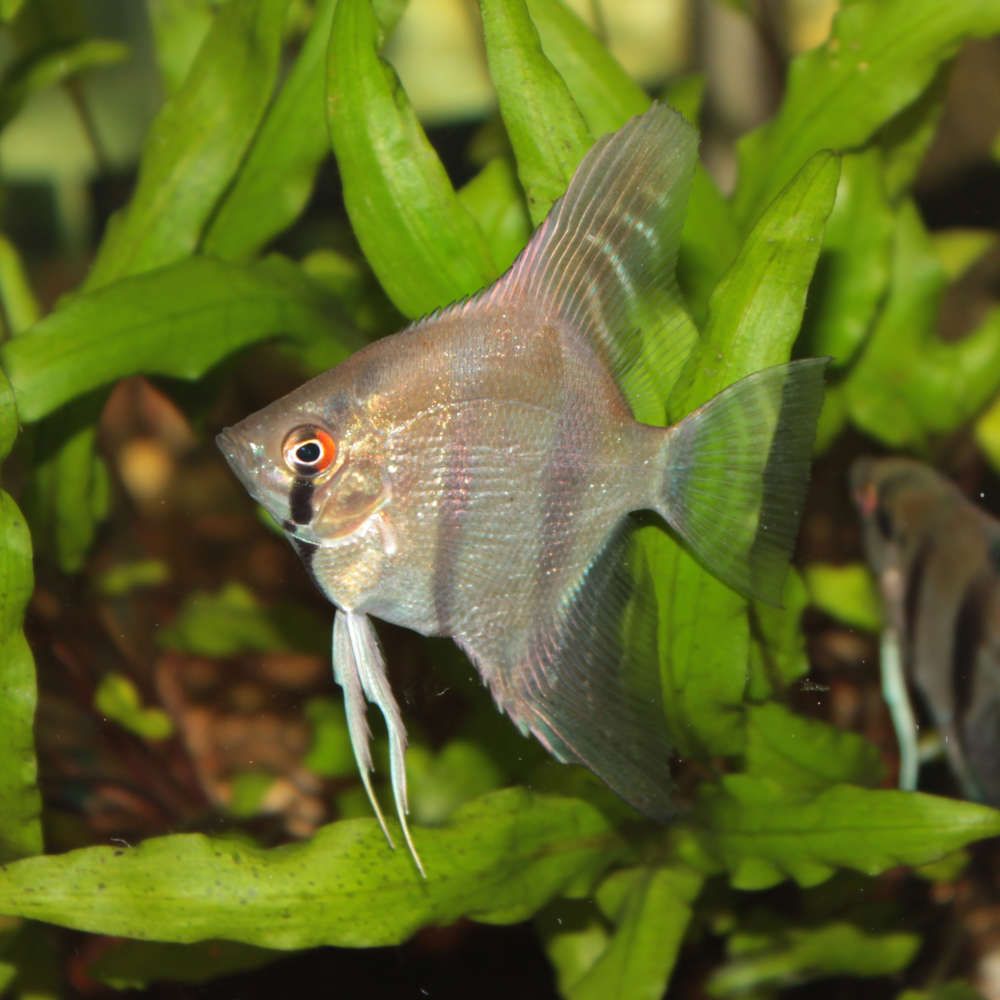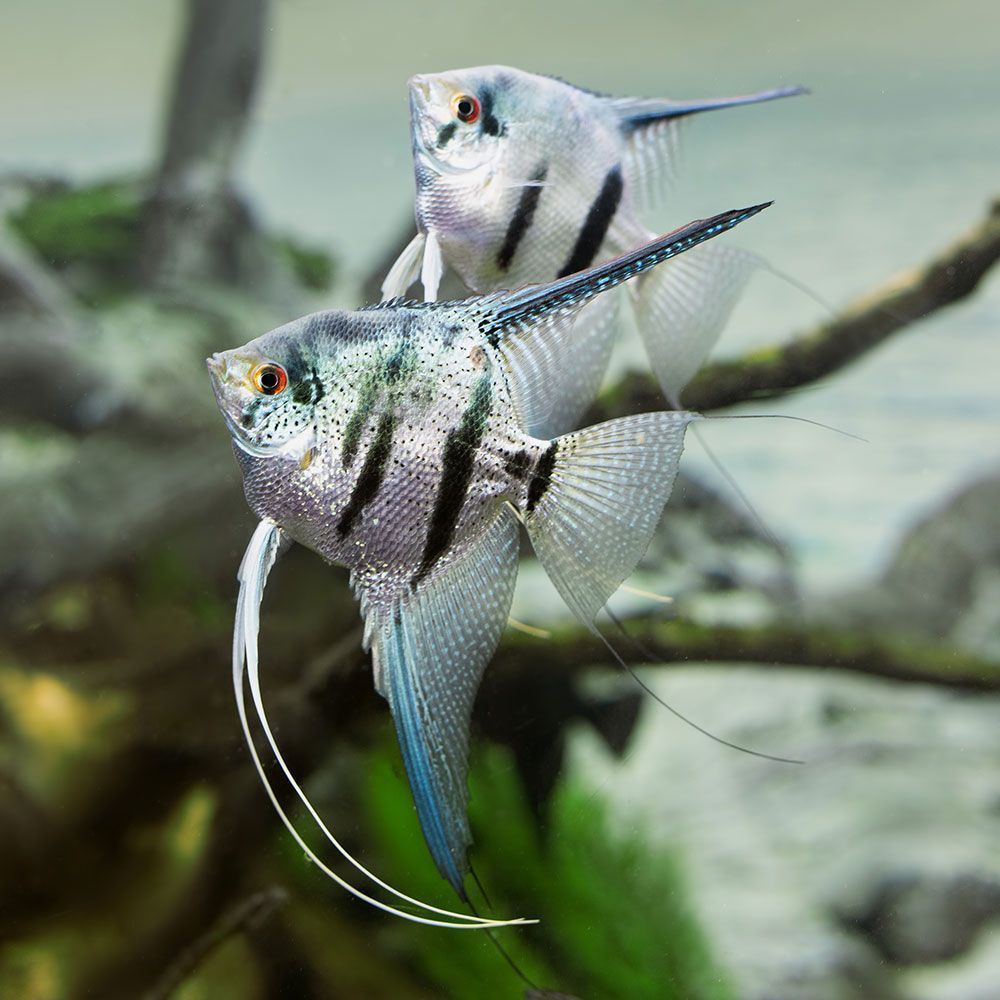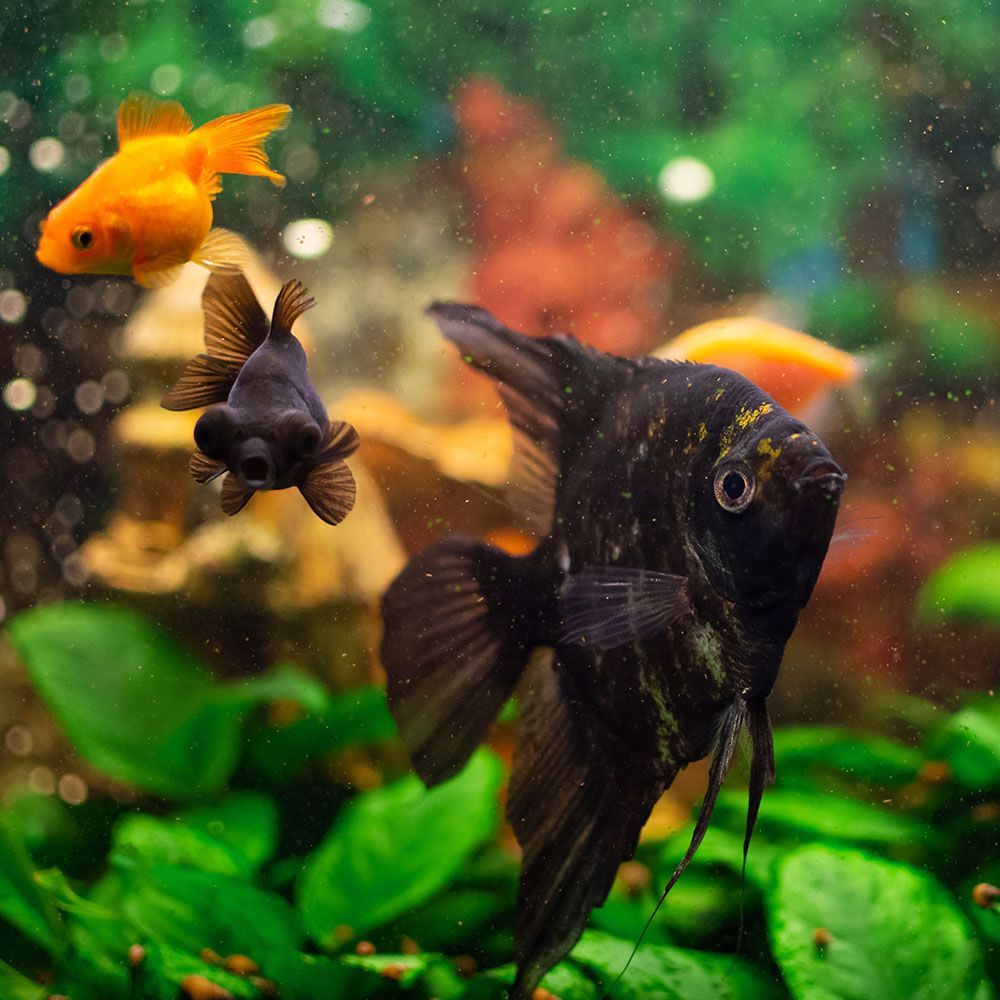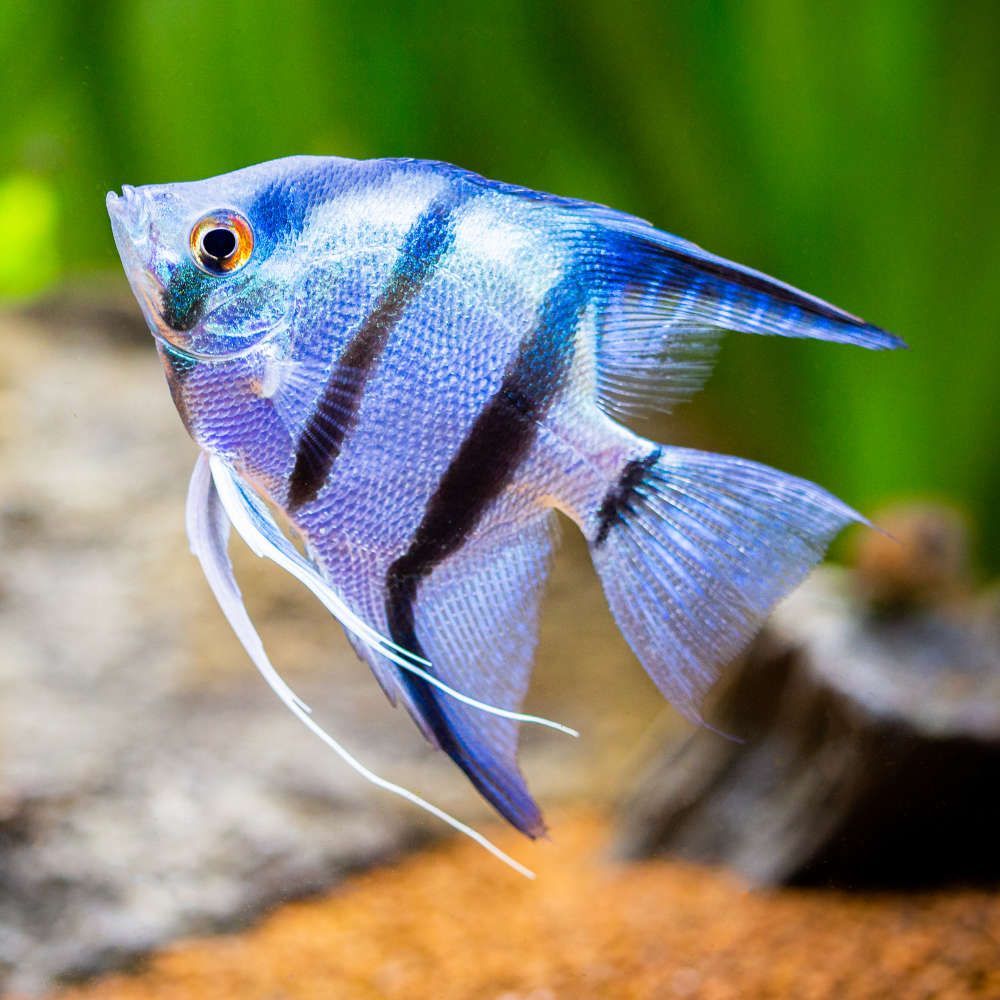The freshwater angelfish, with their exotic long fins and iridescent body, is one of the most flamboyant fish in the tropical aquarium hobby.
The cichlid is unique for bonding with one mate for a lifetime, making most romantics swoon.
So, if you can’t wait to add the fish to your aquarium, keep reading!
What is a Freshwater Angelfish?
Freshwater angelfish, as the name suggests, is a freshwater fish with long fins and an iridescent body.
| Origin | Solimoes River, Ucayali River, Amapa Rivers, Oyapock River, Essequibo River, Brazil, Peru, Colombia, French Guiana and Guiana, South America |
| Order | Cichliformes |
| Family | Cichlidae |
| Scientific Name | Pterophyllum scalare |
| Common Names | Silver angelfish, black angelfish, longfin angelfish, veil angelfish, Scalare, leaf fish |
| IUCN Red List Status | Not Evaluated |
| Appearance | Laterally compressed, triangle-shaped silver fish with black stripes and long fins |
| Size | 15-20 cm (5.9-7.9 in) |
| Weight | 25g |
| Lifespan | Commonly up to 8-10 years, rarely up to 12 years in captivity. Up to 15 years in the wild |
| Temperament | Slightly aggressive, territorial, schooling fish |
| Tank Level | Middle dwellers |
| Water Temperature | 75-86 °F (24-30 °C) |
| pH Level | 6.0-7.5 |
| Water Hardness | Up to 13 dGH |
| Care Level | Medium to Challenging |
| Minimum Tank Size | 125 gallons for 6 |
| Tank Environment | Spacious tall tank, firmly rooted plants, soft substrate, and hiding spaces |
| Diet | Primarily carnivorous and very rarely accepts herbivorous feed |
| Tank Mates | Own school, other slightly smaller calm and non-territorial species |
Which family do Freshwater Angelfish belong?
All Pterophyllum species or angelfish have a laterally flat, triangular, colorful body with long fins and dark stripes.
The Pterophyllum genus belongs to the Heroini tribe, under the Cichlidae family of Cichliformes order.
Currently, the genus comprises three recognized species – Pterophyllum scalare, Pterophyllum leopoldi, and Pterophyllum altum.
Out of all, Pterophyllum scalare is the most popular one, and this article will primarily shed light on it. But before that, let’s take a quick glance at the other type species!
What are the Types of Freshwater Angelfish (Pterophyllum Genus Species)?
While these angelfish aren’t as popular or widely available as the freshwater angelfish, they are equally unique and loved. So, let’s learn a bit about them here!
1. Leopold’s Angelfish (Pterophyllum leopoldi)

- Natural Habitat: Essequibo and Rupununi Rivers, Guyana; Solimoes River, between Santarem and Manacapuru, Brazil; South America
- Other Common Names: Dwarf Angelfish, Teardrop Angelfish, Roman-nosed Angelfish, Longnose Angelfish
- Size: Up to 10 cm (3.94 in) in length, Up to 15 cm (5.9 in) in height
- Lifespan: Up to 10-12 years in captivity, Up to 15 years in the wild
- Tank Level: Middle to top dwellers
- Temperament: Slightly aggressive and territorial
- Diet: Carnivorous
- Tank Mates: Own school, similar or slightly smaller non-territorial calm species
- Minimum Tank Size: 90 gallons for 5 or 6 of them
The fish has a triangular-shaped gold body with black vertical stripes. Leopoldis have about 29-35 scales on their lateral row.
Unlike the rest, they have a faint stripe between the eye stripe and the first dark body stripe. They also flaunt another faint stripe (3/4th the size of the others) between the two bold body stripes.
The fry is born with 8 body stripes which eventually fade, and only 3 remain.
The fish is named after King Leopold III, as he sponsored the Amazonian expedition, which led to the collection of this species.
2. Altum Angelfish (Pterophyllum altum)

- Natural Habitat: Upper Negro River drainage, Amazon River basin; Inirida and Atabapo Rivers, Orinoco River basin; Brazil, Colombia, Venezuela, South America
- Other Common Names: Altum Angel, Altum, Deep Angelfish, Orinoco Angelfish
- Size: Up to 18 cm (7.1 in) in length; Up to 20 cm (7.9 in) in height
- Lifespan: Usually up to 5 or 6 years, but some can live up to 10 or more years
- Tank Level: Middle to top dwellers
- Temperament: Slightly aggressive, territorial
- Diet: Carnivorous
- Tank Mates: Own school, middle to bottom dwelling, calm, non-territorial, slightly smaller species
- Minimum Tank Size: 180 gallons for 6
The laterally compressed greenish-grey or olive fish has an elongated dorsal fin and pointed snout. The body has silver glitters, and the back has a brownish-olive hue.
The pearly grey dorsal and anal fins may be up to 40 cm (15.75 in) long. It also has filamentary and long first rays in the abdominal fins.
The fish body has 4 dark vertical stripes, with the first stripe: across its eye, the second stripe: from short dorsal rays to the beginning of the anal fins, the third stripe: from the top of the dorsal fin to the top of the anal fin; fourth stripe: the beginning of its tail fin.
The fish can change the stripe color depending on its mood – grey, brownish black, or dark black.
What is the Natural Habitat of Freshwater Angelfish?
Naturally, you can spot freshwater angelfish in the Ucayali and Solimoes Rivers of the Amazon River basins throughout Brazil, Colombia, and Peru.
You can also spot it in the Essequibo River of Guiana and the Oyapock River in French Guiana.
The species has also been spotted in Nanay, Momon, and Manacapuru Rivers.
In these water bodies, the fish mainly swims about the mid-depth of rivers near thick and large roots for shelter whenever they sense danger. This kind of habitat is always near the river banks.
How does Freshwater Angelfish Look?
Let’s identify this attractive fish so you don’t miss it while exploring the pet shops.
What is the Size of Freshwater Angelfish?
The adult freshwater angelfish can grow as long as 15-20 cm (5.9-7.9 in). Its height is much longer than its length, up to 20 cm (7.9 in).
What is the Color of Freshwater Angelfish?
The fish has a silver body with three dark stripes on its sides.
Fun Fact: Currently, there are more than 20 types of ornamental freshwater angelfish. Some even say that it is nearly 100.
What are the Features of Freshwater Angelfish?
Freshwater angelfish is laterally compressed, triangular, or leaf-shaped. It also has 35-45 scales on its lateral row along with a notched predorsal contour.
It has four vertical stripes – one through its eyes, the second through the dorsal fin, the third one is about only 0.5 inches long (it doesn’t even reach half of the body), and the last one is a bit before the caudal fin.
There are captivity bred and naturally found color variants, namely koi, panda, fluorescent, chocolate, platinum, leopard, veiltail, ghost, albino, black, half black, blushing blue, blue, marble, and redcap angelfish. The most rare breed of this species is the clown angelfish.
How does Male and Female Freshwater Angelfish differ?
The species has two small spawning tubes from its underbelly. On close inspection, you’ll notice that male fish have sharpened tubes and females have round or cylindrical tubes.
Besides this, the adult male fish has a crown-like bump on his forehead. The female fish also looks fuller from the top. The males also act aggressively during mating season.
However, these differences are better observed in spawning seasons, so it’s not easy to differentiate them sexually.
What is the Behavior of Freshwater Angelfish?
Freshwater angels are pretty territorial towards other species and act lively during meals. The males are slightly aggressive among themselves to establish a hierarchy.
However, it is a calm schooling fish when it doesn’t face any kind of competition. In fact, the fish swims pretty slowly, which doesn’t make it a good fighter either.
When fights break out among the schools, they’ll often establish peace by brushing behavior. In this, the one that gives up first vibrates its tail. If the other fish accepts the truce, it also mimics this behavior, and both brush their tail fins against each other.
What is the Lifespan of Freshwater Angelfish?
In home aquariums, the fish can live up to 8-10 years. However, in my experience, it is possible to increase longevity to 12 years with utmost care.
In the wild, the fish can live up to 15 years.
Author’s Note: Though freshwater angels are slightly aggressive, it can often get harassed for being slow swimmers.
How to take care of Freshwater Angelfish?

Now, if you feel all fired up to bring a group of freshwater angelfish home, then let’s prepare their safe haven here!
What is the Tank Size for Freshwater Angelfish?
Group maintenance is a must to avoid stress-related diseases. So, you must get 6 of them and house them in a 125-gallon tall aquarium to accommodate enough space for its fins.
Of course, if you add more or build a community tank, you need to invest in a bigger tank.
What is the Water Chemistry for Freshwater Angelfish?
The fish is sensitive to water conditions, so try to maintain these digits at all times.
- pH Levels: 6.0-7.5
- Water Temperature: 75-86 °F (24-30 °C)
- Water Hardness: Up to 13 dGH
- Ammonia: 0 ppm
- Nitrite: 0 ppm
- Nitrate: Below 30 ppm
What is the Tank Environment for Freshwater Angelfish?
Next, you must know what things will go in the tank to furnish it perfectly and keep your angels happy!
Which Substrate is required for Freshwater Angelfish?
Use soft, smooth, and fine sand substrate in the aquarium only. The fish is a middle-level dweller and hardly visits the lower levels. But if it does swim downward for any reason, this will protect your angel’s long fins.
Which Plants are required for Freshwater Angelfish?
Only ever use plants with strong roots, like echinodorus, in a tank of angelfish. Many say the fish doesn’t uproot plants, but it’s false for weak-rooted plants.
Which Lighting is required for Freshwater Angelfish?
Use dim and dispersed lighting in the aquarium. You can also use floating plants to disperse the light.
What Décor is needed for Freshwater Angelfish?
Add some bogwood or driftwood to create hiding spots for the fish whenever it feels scared. Ensure no decor has sharp edges, or it might hurt the angelfish fins.
What Filtration is required for Freshwater Angelfish?
Install an efficient oxygenating filter to keep the tank clean of toxins and maintain water chemistry.
What is the Water Flow Rate for Freshwater Angelfish tank?
Keep the water flow slow to medium as the fish isn’t a good swimmer to resist fast flow.
Fish Care Tip: Though aggressive, the angelfish easily gets scared and stressed, even with minimal movements and vibrations. So, never place this tank where there’s too much disturbance.
What do Freshwater Angelfish eat?
Ensure that the angels have a meaty diet to keep them healthy and their colors bright for a long time. Both frozen and live food works, so don’t worry about that. Here are a few things you can keep in their regular diet:
- Daphnia
- Brine Shrimp
- Mosquito larvae
- Small crustaceans and invertebrates
- Tubifex
You can feed them these only once per week
- Bloodworms – Too much of this causes flatulence
- Veggies – It will accept it only if the fish is tank-bred
Feeding Tip: The fish will always want more food, so always take a rough idea from the seller about how much to feed.
What are the Tank Mates for Freshwater Angelfish?

First of all, your tank must have 6 angelfish. Then to ensure the safety of all species, you must only put the following kinds in an angelfish tank:
- Corydoras species
- Similar-sized peaceful tetras (glowlight tetra, black neon tetra)
- Bala sharks
- Platies
- Mollies
- Swordtails
- Guppies (other than Endler’s guppy)
- Bettas
- Bolivian rams
- Gouramis and dwarf gouramis
- Siamese algae eaters
- Keyhole cichlids
Note: Angelfish is carnivorous, so if you want to breed any of the tank mates, use a separate breeding tank.
Which Tank Mates to Avoid with Freshwater Angelfish?
Never house any of these following species in the same tank with angels.
- Small tetras less than 5 cm (2 in) long – they are too small and may get eaten
- Other brightly colored species
- Fast swimmers and fin nippers like Sumatran barbs and rosy barbs
- Large territorial fish of similar size
- Other middle-dwelling fish
- Small shrimps, snails, and crabs – they may get eaten
- Goldfish
- Celestial pearl danio
What are the Common Diseases for Freshwater Angelfish?
The angelfish is susceptible to a number of diseases. So, be prepared to prevent and/or combat these:
| Disease Name | Causes | Symptoms | Treatment |
|---|---|---|---|
| Columnaris | Bacterial Infection | Grey to white patches, frayed fins, inactivity, appetite loss | Improve water quality, add antibiotics, reduce stress |
| PopEye | Immune Response to Injury | Swollen and protruding eyes | Water change, quarantine, add salt or antibiotics, balanced diet |
| Fin Rot | Bacterial Infection | Frayed or disintegrated fins, redness or discolored fins, inactivity, appetite loss | Improve water quality, get rid of sharp objects, and add antibiotics |
| Mouth Fungus | Bacterial Infection | White mass on and around lips that may grow, inactivity, appetite loss | Use concentrated antibiotics with food, reduce stress, perform frequent water changes, clear up any unnecessary decorative objects from tank Note: Critical situation. Treat ASAP |
| Swim Bladder Disease | Bacterial Infection | Floating fish, fish swimming abnormally – curves, sideways, or upside down | Add antibiotics, perform water changes, and maintain proper temperature; stop feeding for 3 days, then feed deskinned boiled and smashed peas |
| Ich | Protozoan Parasitic Infection | White spots, flashing, inactivity, appetite loss | Add aquarium salt or ich medicine, and raise the water temperature |
| Velvet | Parasitic Infection | Color loss, flashing, rapid breathing, fin clamped to the body, yellow film on body, skin peeling, inactivity, appetite loss | Raise water temperature, dim lights for a few days, and add malachite green, aldehyde, or aquarium salt |
| Anchor Worms | Parasitic Infection | Red lesions, inflamed marks on fish skin, dark green thread-like growth on fish skin, flashing, body rubbing against other objects | Add topical antibiotic, and gently pull out worms without stressing the fish For prevention: Quarantine new fish, disinfect all decor |
| Gill Flukes | Parasitic Infection | Redness around gills, labored breathing, excess mucus secretion, flashing, body rubbing against other objects, inactivity, appetite loss | Aquarium salt or all-in-one chemical treatments, enhance water quality Prevention: Rear live feed at home, quarantine new fish |
| Hexamita | Parasitic Infection | Color loss, hemorrhage around its head, red feces, inactivity, appetite loss | Antifungal treatment ASAP |
| Dropsy | Viral Infection | Bloated stomach, protruding scales, redness near vents and fins, ulcers | Improve diet, quarantine, regular water changes, add medicine |
| Iridovirus Angelfish Virus | Viral Infection | Clamped fins, inactivity, swimming with nose tilted upward, slimy body, self-isolation | Quarantine the fish Note: Afatal disease with no cure Prevention: Quarantine new species |
Quick Tip: Always stay prepared with a treatment kit of aquarium salt, Methylene Blue, all-in-one treatments, and a 30-gallon quarantine tank.
How to Breed Freshwater Angelfish at home?
Before you try to breed this fish, keep the following basics in mind.
- Freshwater angelfish sexually matures only after it is 6 months to one year old. It’s not uniform for all specimens.
- Since it’s hard to differentiate sexually, you may seek expert help to choose a healthy pair. However, there’s no assurance that they will mate as it is monogamous and loyal for life. So, buy a school and expect to form a bonded pair naturally.
Once you have a sexually mature mated pair, you must move on to…
What should be the Tank Preparation for breeding Freshwater Angelfish?
Get a tall 50-gallon breeder tank and place it somewhere without any external disturbance. This will help you prevent sudden shock, which might discourage them from mating.
Next, set up the aquarium with these:
- Flat and smooth angular stones, slates, or cones for the fish to lay eggs. Don’t forget to place another stone at the foot of the first one to avoid it slipping and causing accidents.
- Install a sponge filter to keep the water clean but avoid getting young fry sucked.
- To create a shelter for the female fish, you can add a potted sword plant.
- Keep the aquarium bottom clear of any substrate. You can, at most, add spawning mops.
Maintain these water conditions
- Water Temperature: 82 °F (28 °C)
- pH Levels: 6.8
- Water Hardness: 5 dGH
Note: You must also regularly perform water changes and siphoning throughout the spawning and fry development.
Pair Conditioning
Once you identify the naturally formed mates, isolate them in the breeding tank. Keep the pair on a high-quality diet of live, frozen, and flake feed. Some must-have dietary components are white and black mosquito larvae and tubifex.
What is the Pre-Mating Preparation and Mating Process of Freshwater Angelfish?
When the pair feels ready to reproduce, they start cleaning a breeding site of choice. The female rubs her belly on the stone and lays 100-500 eggs at the chosen site, and the male fertilizes them.
After that, the pair ventilates the eggs, cleans them, and even eats the unfertilized eggs. However, if you notice that the pair consumes all eggs – fertilized or not – immediately remove them from the breeding tank.
Remember that not all angelfish will consume their eggs. So, if the pair doesn’t show questionable behavior, don’t remove them.
How to perform Egg Care, Incubation, and Fry Development for Freshwater Angelfish?
If you had to remove the parent pair, you must step up and care for them. Here is a list of steps to maximize breeding success:
- Treat remaining eggs with methylene blue to protect them from fungus.
- Remove any dead eggs – those are white.
The incubation phase lasts for 48 hours if you keep the temperature steady at 81 °F (27 °C). Initially, the fry will consume its nutrients from its egg sac.
The young fish will become free swimmers after 5 days of hatching. That’s when you must feed them baby brine shrimp twice or thrice a day.
The young angelfish will start forming their shape after about 20 days.
Breeding Tip: Sometimes, females form bonded pairs. So, it’s better to get the pair checked by experts to ensure their gender. Otherwise, you will waste your time and resources on non-viable spawning.
How to Buy Freshwater Angelfish?
Choose the freshwater angelfish that seems:
- Most active and energetic of the bunch
- Has shiny scales and vibrantly colored
Don’t buy any angelfish that seems drowsy, has visible fin issues, seems pale, or has white spots.
A word from FishInAquarium
The freshwater angelfish is not just a treat to the eye but also to your heart. With the perfect skills, they will accompany you for years to come.
Whether it is the elegant movements around your tank or the gluttonous behavior during meals, you will never get bored of watching them. With that, if you feel ready to get your share of angels, definitely share it with other fish enthusiasts. And if you or your friend have some queries, hit us up on our mail, and we’ll come back with all the answers!


